“Ore no Shikabane o Koete yuke” is often translated as “Over my dead body,” which is what it means, but not in the usual sense of “Hell no!” More like “Cross over a river of the dead bodies of your ancestors until you finally manage to kill the boss,” which isn’t nearly as catchy. Not that it matters; they could have called this game Poopstained Bloody Avengers and it would still be just as awesome.
It’s on the PSX and it’s on the PSP. If you get the chance you should definitely play it. Don’t ask any questions, just do it. Is it– YES! Should I– YES! What about– YES! YES! YES! YES, just play the darned thing already!
Good, now that we’ve gotten all that ‘review’ stuff out of the way, it’s time to post some screenshots I took along the way. But first the backstory, which is simple enough. A demon named Shuten Douji killed a man and his wife and placed a curse on their son which dooms him to live out his entire lifespan in 2 years or less. He can’t have kids with normal humans either, but the gods intervene so he can breed with them instead. The rest of the game is about fighting, leveling up, getting money/treasure and passing on your genes to the next generation so they can continue the vendetta until they finally kill the boss.
First the people doing the fighting: the Shitanomori clan (named by me). With their lifespans so short you’ll be going through a LOT of characters, but the photo gallery lets you memorialize them like so:
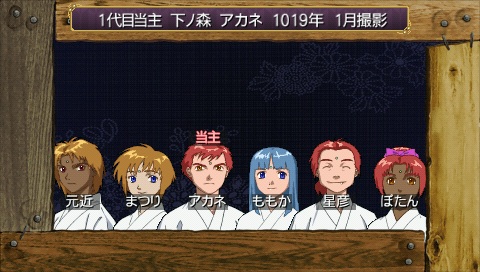 The guy with the mark on top of his head is the original main character, Akane, along with 4 of his kids and one grandkid. In honor of his passing all subsequent family heads adopt the name ‘Akane.’ I went through 76 Akanes before finishing, which is entirely too many. I’ll tell you how to avoid this fate in a later post but for now let’s look at character stats.
The guy with the mark on top of his head is the original main character, Akane, along with 4 of his kids and one grandkid. In honor of his passing all subsequent family heads adopt the name ‘Akane.’ I went through 76 Akanes before finishing, which is entirely too many. I’ll tell you how to avoid this fate in a later post but for now let’s look at character stats.
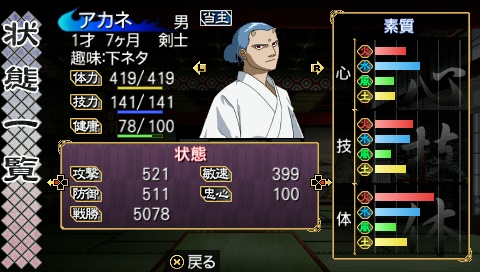 From top to bottom you have the character name, gender, age (at 1 year 7 months he could drop perma-dead at any moment), hobby (just for fun), HP, MP and Health (used for special attacks, if it drops to zero your character has a good chance of perma-dying). In the purple box is his attack, defence, total EXP gained, agility and loyalty to the family. The lower the loyalty, the more likely a character is to run away for good. Press the left/right button to see weapons equipped and more detailed levels.
From top to bottom you have the character name, gender, age (at 1 year 7 months he could drop perma-dead at any moment), hobby (just for fun), HP, MP and Health (used for special attacks, if it drops to zero your character has a good chance of perma-dying). In the purple box is his attack, defence, total EXP gained, agility and loyalty to the family. The lower the loyalty, the more likely a character is to run away for good. Press the left/right button to see weapons equipped and more detailed levels.
The colored lines on the right represent other stats. Fire = red, Water = blue, Air = green, Earth = yellow. The first set of four, Heart, show the character’s temperament. More water = more loyal, more red = less loyal, more attack-oriented, that sort of thing. The second set, Skill, shows magic def/atk. More fire = better fire magic atk and def, etc. The last set, body, stands for physical stats. Fire = phys attack, Water = HP, Air = agility, Earth = phys def. All three sets affect the kind of magic your character can learn.
Since all your characters, no matter how wonderful, will die permanently between the ages of 1 year 7 months and 2 years, you have to keep the bloodline going by breeding constantly with gods/goddesses. To do this you need “Worship points”, which are earned along with EXP. When you have enough, you go to the breeding screen and check out the resumes of the gods available, like so:
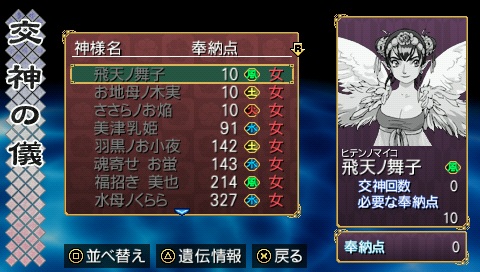 They all come with a resume of dominant and recessive “genes” i.e. stats that may or may not manifest in your offspring. You might be wondering if there’s a, uhh, ‘physical’ element to breeding or not. Fortunately/unfortunately the game is deliberately ambiguous on the matter so you’ll have to use your imagination. Either way you end up with a child (or twins) like so:
They all come with a resume of dominant and recessive “genes” i.e. stats that may or may not manifest in your offspring. You might be wondering if there’s a, uhh, ‘physical’ element to breeding or not. Fortunately/unfortunately the game is deliberately ambiguous on the matter so you’ll have to use your imagination. Either way you end up with a child (or twins) like so:
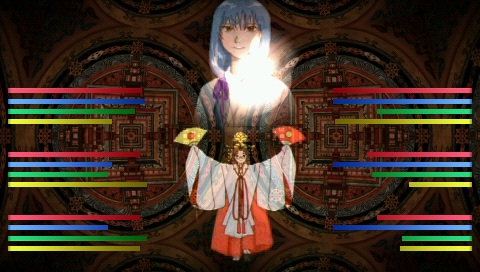 Don’t quote me on this, but I’m almost certain the stats on the left are the “father’s side” genes and the ones on the right are the “mother’s side” genes. You won’t know which set the kid gets until they show up a month later. The set they don’t have may or may not be passed on on to their kids, making this whole breeding thing kind of a crapshoot. I think a character’s dominant stats also affect their hair, eye and skin color but again don’t quote me on that. Once the kid shows up a month later you give them a name and pick a class for them.
Don’t quote me on this, but I’m almost certain the stats on the left are the “father’s side” genes and the ones on the right are the “mother’s side” genes. You won’t know which set the kid gets until they show up a month later. The set they don’t have may or may not be passed on on to their kids, making this whole breeding thing kind of a crapshoot. I think a character’s dominant stats also affect their hair, eye and skin color but again don’t quote me on that. Once the kid shows up a month later you give them a name and pick a class for them.
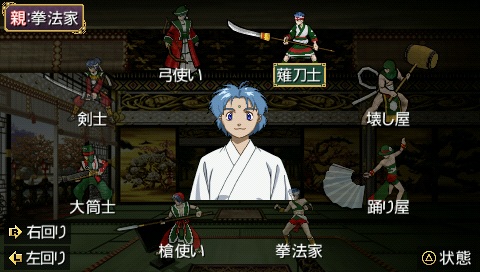 Clockwise from the highlighted job it’s Naginata fighter, Demolisher, Dancer, Martial Artist (best class), Lancer, Gunner, Swordsman and Archer (second-best class). The purple box in the upper left shows what class his parent is. This is important if the parent knows a special move: they can only pass it on to one kid who is in the same class. This can only be done in the first two months by having that parent train them. 2 months later, they’re ready to fight.
Clockwise from the highlighted job it’s Naginata fighter, Demolisher, Dancer, Martial Artist (best class), Lancer, Gunner, Swordsman and Archer (second-best class). The purple box in the upper left shows what class his parent is. This is important if the parent knows a special move: they can only pass it on to one kid who is in the same class. This can only be done in the first two months by having that parent train them. 2 months later, they’re ready to fight.
Pick a party, any party, equip them and send them out. The world map looks like this, only with 3-5 dungeons when you first start out. Uhh oops, I seem to have lost that screenshot. Have a random obituary instead:
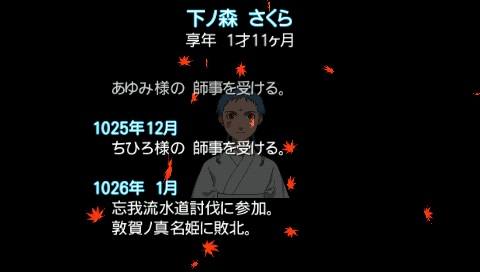 There are also 2 seasonal dungeons that can only be visited in June-July and November-December respectively. Pick a dungeon – they’re all around the same level to start with – and explore.
There are also 2 seasonal dungeons that can only be visited in June-July and November-December respectively. Pick a dungeon – they’re all around the same level to start with – and explore.
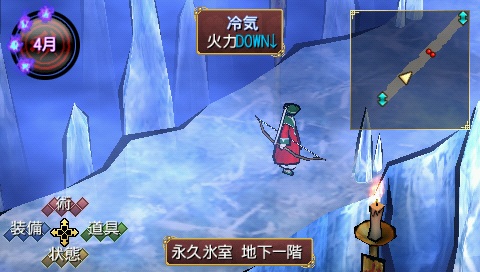 Dungeon maps aren’t displayed by default; you have to use items or skills to show everything. The round thing in the upper left shows the current month and the blue flames show how much time you have left before the end of the month. You can keep exploring into the next month and on and on, but it’ll play havoc with the health and stats of very young and very old members. The bottom left has shortcuts for skills, items, status and equipment. The blue arrows on the map show entrances/exits and the red dots stand for enemies. Approach them to get into battle.
Dungeon maps aren’t displayed by default; you have to use items or skills to show everything. The round thing in the upper left shows the current month and the blue flames show how much time you have left before the end of the month. You can keep exploring into the next month and on and on, but it’ll play havoc with the health and stats of very young and very old members. The bottom left has shortcuts for skills, items, status and equipment. The blue arrows on the map show entrances/exits and the red dots stand for enemies. Approach them to get into battle.
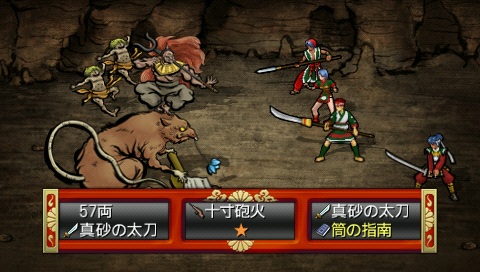 The roulette shows what you’ll get if you win the battle. Three of the same item = double EXP. Three stars = triple EXP. Yellow items = stuff you haven’t gotten yet. AFAIK the roulette is fully automatic and stops when/wherever it wants. BTW the yellow item in this case is a Gunner’s manual, which I will need before I can use the Gunner class.
The roulette shows what you’ll get if you win the battle. Three of the same item = double EXP. Three stars = triple EXP. Yellow items = stuff you haven’t gotten yet. AFAIK the roulette is fully automatic and stops when/wherever it wants. BTW the yellow item in this case is a Gunner’s manual, which I will need before I can use the Gunner class.
Battle itself is the usual turn-based stuff. The characters will suggest moves they want to use, based on the situation and their temperaments. Rejecting too many suggestions will hurt their loyalty but since anyone who gets KO’ed in battle stands a very good chance of perma-death after battle, you have to do whatever it takes to survive. The nice thing about the battles in OreShika is that you only have to defeat the enemy leader to win and get all the items. The leader might even run off with the spoils if you’re not careful, so if you get into a sticky situation you can just focus on taking out the leader.
In emergencies or if you just want to do extra damage, you can have characters joint-cast the same magic to do up to 8 times normal damage:
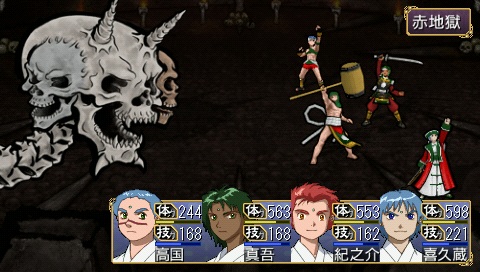 I should have waited a few seconds to take a shot of the resulting payoff, which wiped the boss out in one hit. It’s worth trying to pull an attack like that off if you’re confident you can keep everyone alive long enough to do so. An even better option is to have a parent and child pull off a joint attack using one of their family specials. That’s how I beat almost every boss worth beating, because the damage dealt is truly staggering. The game tells us a grandparent-parent-child attack is even better than that, but for logistical reasons I never pulled one off.
I should have waited a few seconds to take a shot of the resulting payoff, which wiped the boss out in one hit. It’s worth trying to pull an attack like that off if you’re confident you can keep everyone alive long enough to do so. An even better option is to have a parent and child pull off a joint attack using one of their family specials. That’s how I beat almost every boss worth beating, because the damage dealt is truly staggering. The game tells us a grandparent-parent-child attack is even better than that, but for logistical reasons I never pulled one off.
That’s most of the game in a nutshell. Raise your kids, visit dungeons, earn money and weapons and skill scrolls to pass on to the next generation, earn Worship Points so you can breed with better and better gods and keep going till you can beat the final boss. Various sub-bosses will drop fragments of story if/when you beat them, but 1) It’s not required and 2) This really isn’t a story-oriented game. It’s all about revenge!
Let’s round this up with the home menu:
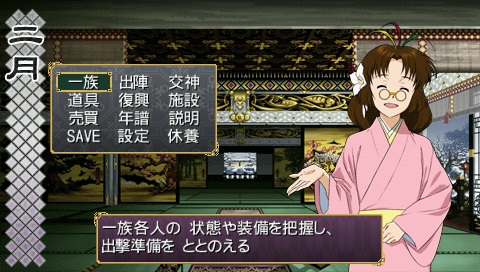 The lady is Itsuka, our perky immortal family retainer. From left to right, top to bottom the options are:
The lady is Itsuka, our perky immortal family retainer. From left to right, top to bottom the options are:
Family: Check your family’s status, pick a party, equip them, train the young ones, etc.
Items: Store, sort, use, dispose of items.
Buy/Sell: Exactly what it says on the tin.
SAVE: Exactly what it says on the tin.
Sortie: Go dungeon-crawling/take part in a tournament.
Reconstruction: Rebuild the city after it was destroyed by demons. Donating money to the city improves store inventories, reduces the WP you need to breed and adds a variety of services and facilities.
Chronology: Family tree, family facts, family history. Also where you can store family photos.
Settings: Exactly what it says on the tin. You can make the game as hard or as easy as you like here.
Breed: (lit: mix with a god) Exactly what it says on the tin.
Facilities: Medicine shop, photographer’s shop, goods trading point and some other things I can’t remember.
Explanations: Giant walls of text about anything and everything in the game.
Rest: Let a month pass by so everyone can recover their health. Don’t use if you can avoid. In fact, just don’t use.
Armed with this info and a minimum amount of Japanese knowledge, you too can play Ore no Shikabane wo Koete yuke. It’s not a perfect game by any means (I’ll cover the flaws in another post), but it’s a lot of fun for anyone who likes dungeon-crawlers even just a tiiiiny little bit. It took me 60-80 hours on the Normal setting to finish this, but with a more efficient playing style you can do it half the time or less. I hope it comes to the west or gets a fan-patch someday so more people can try it.
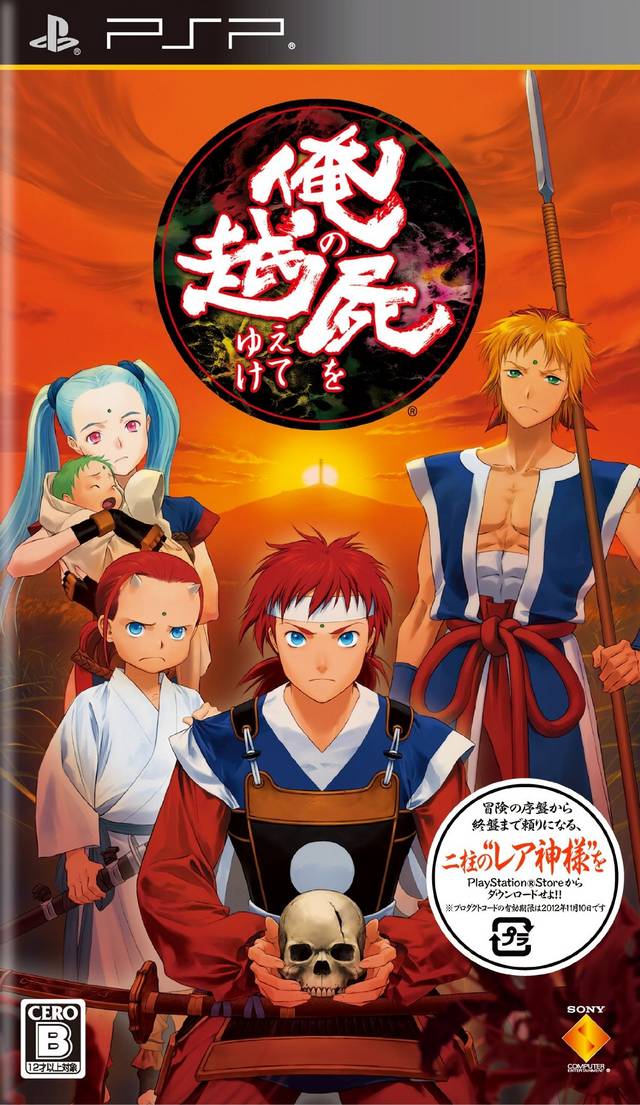
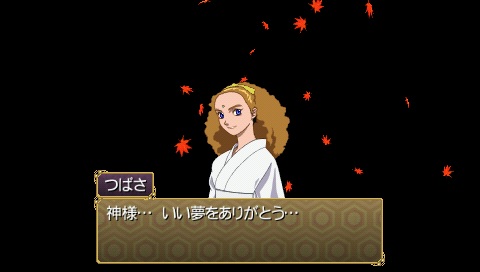
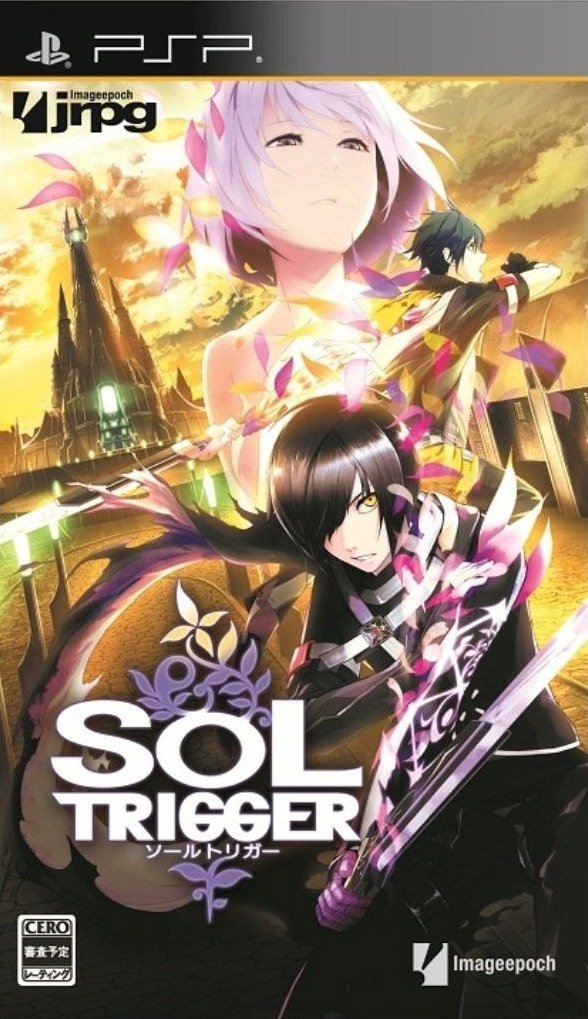
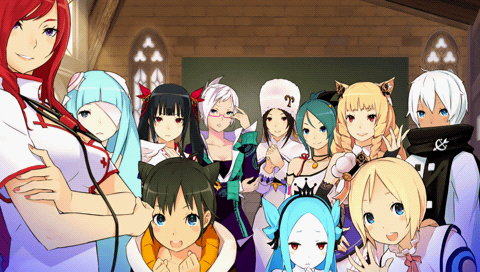
Hmm, I’ve heard good things about this game but I’ve been holding back because it seems rather Kanji heavy, which is like a weakness to me.
But I guess if it’s really not that hard to play I might consider starting it if I didn’t already have 2 3DS games to beat first.
It is pretty kanji-heavy, but as long as you know enough to figure out what the items do you can ignore everything else.
What are you playing on the 3DS? The only 3DS games that have caught my eye so far are Rune Factory 4, Harvest Moon Origins (sorta), Bravely Default (sorta) and Fire Emblem Awakening (want, but not enough to buy a 3DS).
Fire Emblem: A and Etrian Odyssey IV. Both are meaty RPGs which convinced me to plop down money for it. I’m looking forward to the upcoming Shin Megmami Tensei games too.
I would be interested in the upcoming Super Robot Wars and Bravely Default also if it wasn’t for Nintendo’s boneheaded decision to implement region locking, so I guess I’m going to have to wait and see what happens on those.
Etrian Odyssey. Ah, now there’s a series I need to try. I know where I can borrow the first one, but I’m told the sequels are much-improved.
And yes, I’m not getting a 3DS until someone figures out how to crack that stupid region lock. Here I am ready and willing (okay, not so willing) to purchase Japanese games hot off the press and some nutbrained executive is telling me they don’t want my money.
Right now my personal preference for EO as a series is…
EO3 > EO4 > EO1 > EO2
Although maybe I should remove EO4 from that list because I’m only a few hours in so that’s probably not a fair judgement of it.
EO 1 is… very classic, balls hard grindy dungeon crawler, for anyone who likes that sort of things. There are several balance issues like needing specific skill builds to avoid being doomed to failure so I would recommend an FAQ. I personally think it has the most interesting narrative out of all the games but I haven’t seen 4.
EO 2 is a confused mess of a sequel which doesn’t know what it wants to do and I believe a lot of its changes make the game worse. I don’t feel like going into detail since it would be kind of pointless without knowing the mechanics of 1. I think it also has the weakest plot out of all the EOs (though I realize no one plays dungeon crawlers for their plot)
EO 3 is my favourite but it’s really “off the wall” in terms of creativity and “wackiness” of its new mechanics/flavour. I love how all the classes were all non-traditional and interesting. I think it’s the love/hate of the EO series but personally I love it though playing EO1 is nice to establish a “baseline” first before going into 3. The narrative of this game is more “traditional” which is a mixed bag to me.
EO 4… not that far in, but they scaled back the “creativity” to return to the most standard fantasy tropes of EO 1… if I could describe the game right now, EO 4 is EO 1 if the developers had the accumulated experience before they started. 3 was more creative and that’s why I liked it more, but 4 is definitely a more polished experience for the start of a new console.
Sounds like I need to start with EO1 as a baseline and then move on to one of the others depending on what I like/don’t like about it. Since it’s legendarily rock hard I don’t expect to finish it, but it should be an interesting experience either way.
I personally find EO3 to be the best as well, not only are the classes refreshing and well made by themselves, they also compliment each others in ways that makes me giddy with joy whenever I find new synergies between them. I’d love to play EO4 as well but the region locking still makes me hesitate about getting a 3DS.
Yeah but I wouldn’t appreciate all the changes EO3 made without first playing the ‘inferior’ original. Plus I like to play in order where possible.